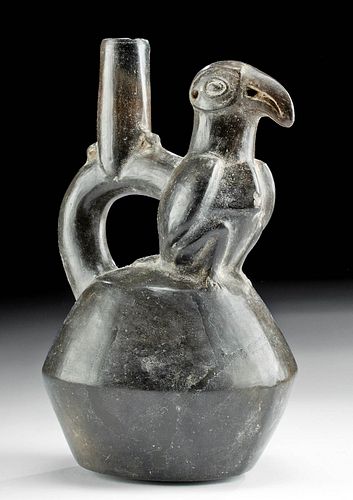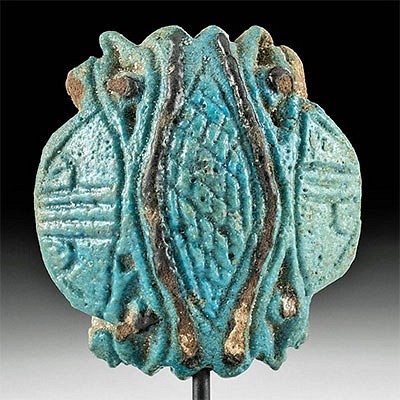Chimu Blackware Stirrup Vessel w/ Parrot
Lot 170
About Seller
Artemis Fine Arts
686 S Taylor Ave, Ste 106
Louisville, CO 80027
United States
Selling antiquities, ancient and ethnographic art online since 1993, Artemis Gallery specializes in Classical Antiquities (Egyptian, Greek, Roman, Near Eastern), Asian, Pre-Columbian, African / Tribal / Oceanographic art. Our extensive inventory includes pottery, stone, metal, wood, glass and textil...Read more
Categories
Estimate:
$400 - $600
Absentee vs Live bid
Two ways to bid:
- Leave a max absentee bid and the platform will bid on your behalf up to your maximum bid during the live auction.
- Bid live during the auction and your bids will be submitted real-time to the auctioneer.
Bid Increments
| Price | Bid Increment |
|---|---|
| $0 | $25 |
| $300 | $50 |
| $1,000 | $100 |
| $2,000 | $250 |
| $5,000 | $500 |
| $10,000 | $1,000 |
| $20,000 | $2,500 |
| $50,000 | $5,000 |
| $100,000 | $10,000 |
| $200,000 | $20,000 |
About Auction
By Artemis Fine Arts
May 27, 2021
Set Reminder
2021-05-27 10:00:00
2021-05-27 10:00:00
America/New_York
Bidsquare
Bidsquare : CLEARANCE | Antiquities & Ethnographic Art
https://www.bidsquare.com/auctions/artemis-gallery/clearance-antiquities-ethnographic-art-7010
Featuring discounted pricing and many new items! Asian art, Classical antiquities from Egypt, Greece, Italy, and the Near East...plus Pre-Columbian, Tribal, Russian Icons & Enamelware, Spanish Colonial, Fine Art, more! Some starting prices have been reduced up to 65% from original auction prices! Artemis Fine Arts info@artemisgallery.com
Featuring discounted pricing and many new items! Asian art, Classical antiquities from Egypt, Greece, Italy, and the Near East...plus Pre-Columbian, Tribal, Russian Icons & Enamelware, Spanish Colonial, Fine Art, more! Some starting prices have been reduced up to 65% from original auction prices! Artemis Fine Arts info@artemisgallery.com
- Lot Description
**First Time At Auction**
Pre-Columbian, Central Coast Peru, Chimu, ca. 1100 to 1470 CE. An impressive hand-built and highly burnished blackware pottery vessel exhibiting an ovoid base, a wide central hip, and a rounded top capped with a tubular stirrup spout and the figure of a seated parrot. The ancient bird presents a puffed-out chest and folded wings above a pair of long legs, each bent at the knee. Supported by a thick neck, the creature's avian visage features a lengthy, curved beak with an incised mouth and bulging, target-motif eyes. A petite bunch of tailfeathers projects from the parrot's posterior and two small nubs flank the stirrup spout. The animal's head displays an annular drill hole, possibly for suspending the lovely vessel for travel. Size: 4.25" in diameter x 7.625" H (10.8 cm x 19.4 cm)
In the Pre-Columbian world, birds were regarded as sky animals associated with the sun, moon, and Venus - where they served as messengers between humankind and the deities. Of particular importance were the eagle, parrot, and hummingbird. The beak of the bird depicted on this example is closest to that of a parrot. Parrots were and continue to be revered by the ancients of South America. Their brilliant plumage and ability to fly high above the treeline made them ideal incarnations of the sky deities, thought to be endowed with supernatural powers of celestial origin.
Provenance: ex-Stein collection, Bloomfield Hills, Michigan, USA, acquired prior to 2010; ex William Micol collection, Milford, Michigan, USA
All items legal to buy/sell under U.S. Statute covering cultural patrimony Code 2600, CHAPTER 14, and are guaranteed to be as described or your money back.
A Certificate of Authenticity will accompany all winning bids.
We ship worldwide and handle all shipping in-house for your convenience.
#163929Repaired from several pieces with restoration over break lines. Restoration to rim and some to base. Chip to chest of parrot. Expected nicks and abrasions. Otherwise, very nice with light earthen deposits in recessed areas.Condition
- Shipping Info
-
All shipping is handled in-house for your convenience. Your invoice from Artemis Gallery will include shipping calculation instructions. If in doubt, please inquire BEFORE bidding for estimated shipping costs for individual items.
-
- Buyer's Premium



 EUR
EUR CAD
CAD AUD
AUD GBP
GBP MXN
MXN HKD
HKD CNY
CNY MYR
MYR SEK
SEK SGD
SGD CHF
CHF THB
THB














